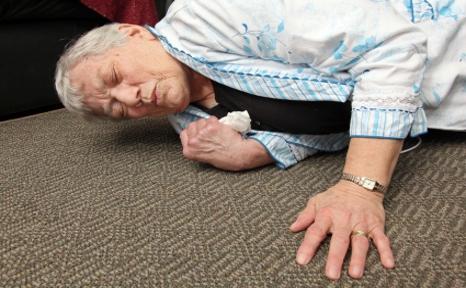


Here’s a triple threat you may have overlooked. As someone with rheumatoid arthritis, you’re at a greater risk for osteoporosis. And arthritis and osteoporosis both make you more likely to suffer a slip or fall that could threaten your health and independence.
With all the treatments and issues surrounding your arthritis, taking steps to minimize the risk of slips and falls is an easy one to procrastinate or miss. But if your bones are fragile, a fall that wouldn’t ordinarily hurt you can cause a serious and debilitating fracture. And if a bone doesn’t break, it can still cause painful arthritis flare-ups. It’s essential to do all you can to prevent falls if you have osteoporosis and/or arthritis.
The good news is that, while common (more than 1.5 million people suffer a bone-disease-related fracture each year), most slips and falls can be prevented with precautions that take very little time, energy or money to implement. Take the time to identify the hazards and use the following tips:
Remove clutter like newspapers, shoes, toys, clothes and more that might cause tripping. Get rid of throw rugs, especially ones on linoleum, tile or wood floors, or make sure they have skid-proof backing. Put grab bars in your shower, a rubber mat in the tub and non-skid bath mats on the floor. Repair bulges in carpeting and make sure you don’t have loose cords running across your floors. Close drawers throughout the house and use sturdy step stools – not chairs or boxes – to reach high items. Install banisters and railings on your stairs, and go down them at an angle to get more of your foot on each stair.
Also, don’t forget the outside of your home. Light walkways and stairs outside, and during the winter, make sure walkways are dry and free of ice.
No, not for fashion’s sake. The right footwear is key to keeping you safe. Traction – or a high level of friction between your shoe and walking surface – is what keeps you from slipping. Obviously, high heels with minimal surface contact are a bad idea. Shoes with leather or other hard, smooth-surfaced soles can lead to slips and injuries, too. Look for slip-resistance shoes with rubber or soft soles and heels to get that good, safe friction. And don’t forget this applies to house shoes: slick or backless slippers are a big risk.
Sometimes your environment doesn’t cause a slip or fall; it might simply be the result of a clumsy, uncoordinated moment. Exercises like yoga and pilates strengthen your core and develop balance, but even general strength exercises like walking are helpful. Also, be sure to have your hearing and vision checked regularly to make sure those “clumsy moments” aren’t actually the result of decreased senses. And, yes, this might mean using a cane and walker if you’re still unsteady on your feet. It’s worth it.
Copyright © www.orthopaedics.win Bone Health All Rights Reserved